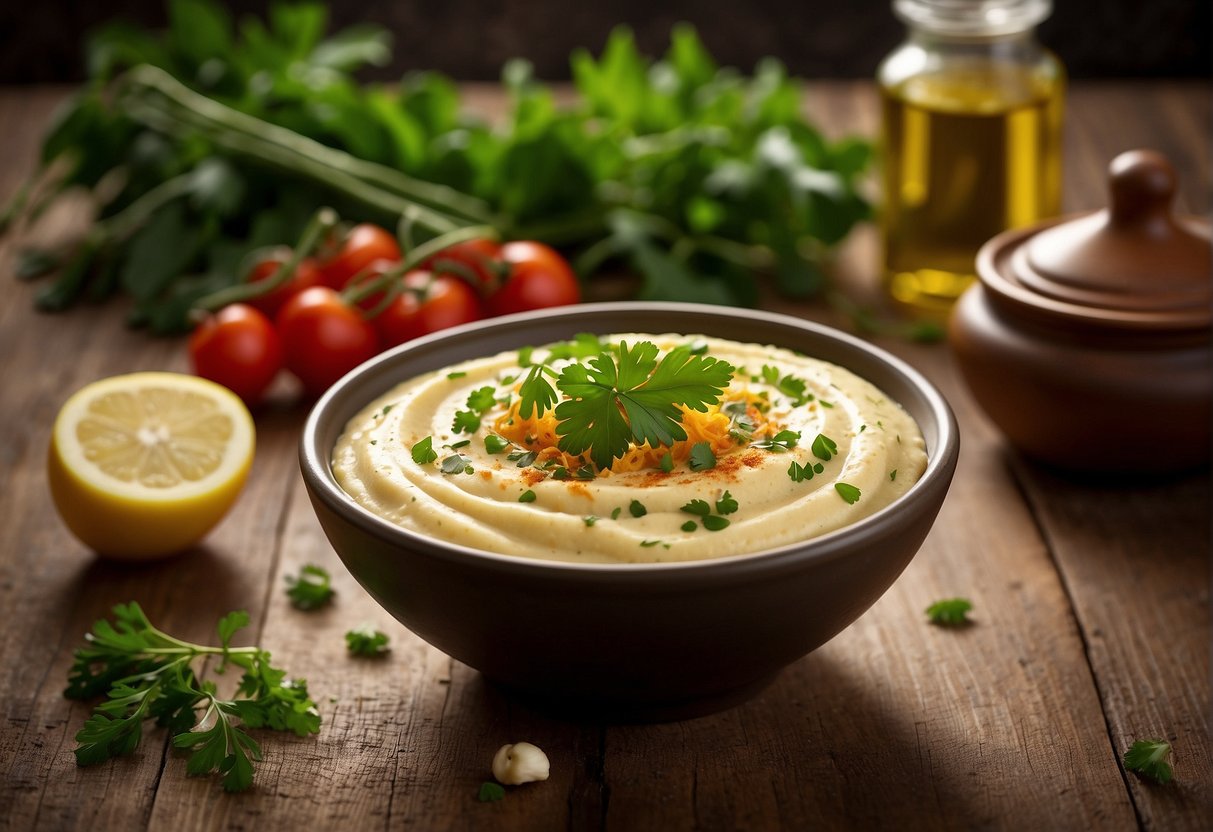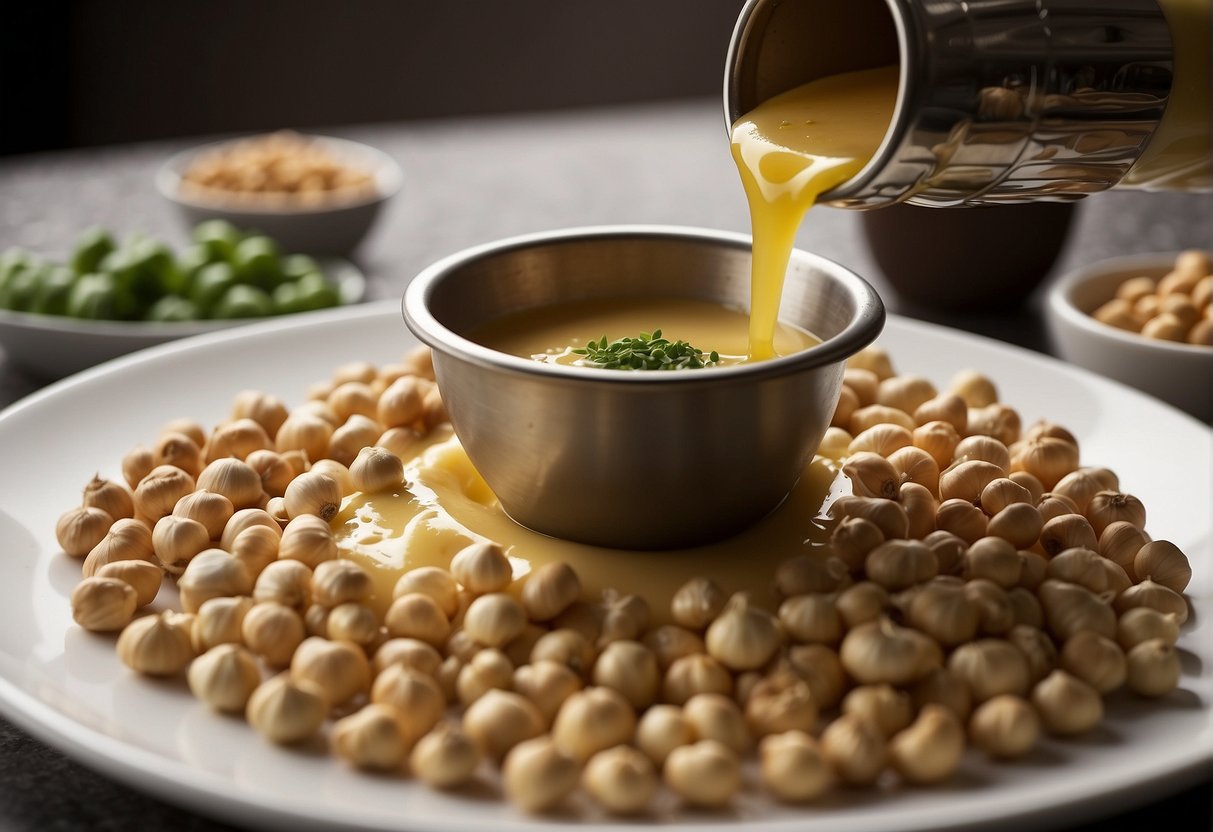Garlic hummus has gained popularity over the years as a delightful and healthy dip, enjoyed by people all over the world. The creamy texture of this chickpea-based spread, combined with the robust flavors of garlic, tahini, and lemon juice, make it the perfect companion for crunchy vegetables, warm pita bread, or as a spread on your favorite sandwich.
To achieve the perfect smooth hummus, there are a few important techniques to keep in mind. First, consider using dried chickpeas instead of canned, as they tend to deliver better flavor. Overcooking the chickpeas with baking soda ensures they blend easily and create that creamy consistency. Another tip is to add the tahini and lemon juice to your food processor first, blending them until they form a smooth paste before adding the other ingredients.
Mastering the art of smooth garlic hummus might take some practice, but by following these easy steps, you will be well on your way to impressing your friends and family with a delicious and healthy homemade treat.
Essential Ingredients

Chickpeas: Canned vs. Dried
For a smooth garlic hummus, chickpeas are the base ingredient. You can use either canned or dried chickpeas, depending on your preference. Canned chickpeas are convenient and save time, but they might not yield the creamiest hummus. For a smoother texture, use dried chickpeas. Soak them overnight, then cook them until tender. Remove their skins for an even smoother hummus. If using canned chickpeas, try peeling off the skins as well.
The Role of Tahini
Tahini, a paste made from ground sesame seeds, is an essential ingredient in hummus. It provides a rich and nutty flavor that perfectly complements the other ingredients. Make sure to choose a high-quality tahini that has a smooth and pourable consistency. To get the creamiest texture, start by blending the tahini with lemon juice before adding other ingredients.
Basic Tahini Recipe:
- 1 cup sesame seeds
- 2-4 tbsp olive oil or other neutral oil
- Pinch of salt
Types of Oil to Use
Olive oil is a key ingredient in hummus, as it adds a fruity and smooth element. However, other neutral oils such as grapeseed, sunflower, or canola can also be used. Generally, it’s best to use a less strongly flavored oil to let the other flavors shine. To achieve an extra smooth hummus, add oil slowly while blending the chickpeas.
Flavor Enhancers
The following ingredients can enhance the flavor of your garlic hummus:
- Garlic: Use fresh garlic for a strong flavor. For a milder taste, roast the garlic before adding it to your hummus.
- Lemon juice: Fresh lemon juice adds brightness and acidity to the hummus. Begin by adding a few tablespoons, then adjust to your taste.
- Ground cumin: A small amount of ground cumin adds depth and warmth to the hummus recipe. Use about 1/2 to 1 teaspoon, depending on your preference.
- Salt: Salt brings out the flavors of all the other ingredients. Start with a small amount and adjust to your liking.
Preparation Techniques

Achieving Smooth Texture
To achieve a smooth texture in your garlic hummus, using a food processor is highly recommended. However, a blender can also work, but it might require more effort to achieve the desired consistency. It is important to follow these steps:
- Rinse the chickpeas: It helps remove any skins that may be present and can negatively affect the texture.
- Use baking soda: Adding a small amount of baking soda to the chickpeas while cooking can help break down the skins and tenderize them. This will result in a smoother hummus. source
- Blend tahini and lemon juice first: Puree the tahini and lemon juice before adding other ingredients to ensure a smooth, creamy base. Process longer: For a smoother texture, blend the hummus longer than you think is necessary, as it helps to break down the chickpeas even further.
- Consider using aquafaba: Aquafaba, the liquid from canned chickpeas, can be a useful ingredient to help loosen up the hummus while blending, thus achieving a smoother consistency. source
Roasting Garlic for Depth of Flavor
Adding roasted garlic to your hummus can elevate the flavor and create a more complex taste profile. Roasting the garlic mellows the pungent garlic taste and adds a natural sweetness, complementing the nuttiness of the tahini and the earthiness of the chickpeas.
To roast garlic, follow these simple steps:
- Preheat the oven: Set your oven to 400°F (200°C).
- Prepare the garlic: Cut off the top of a whole garlic bulb, exposing the cloves. You can use as many bulbs as you want, depending on the desired garlic intensity.
- Season the garlic: Drizzle the exposed cloves with olive oil and sprinkle with some salt and pepper.
- Wrap and roast: Wrap the garlic bulb(s) in aluminum foil and place them in the preheated oven. Bake for 30-40 minutes, or until the cloves are soft and golden brown. source
- Combine with other ingredients: After your garlic has cooled, squeeze the softened cloves out of their skins and blend them with the other hummus ingredients in the food processor or blender.
By following these techniques and making adjustments according to your taste preferences, you can create a deliciously smooth and flavorful garlic hummus to enjoy and share with others.
Flavor Variations
Traditional Seasonings
In a classic smooth garlic hummus recipe, you will usually find a blend of cumin, paprika, and sumac as the primary seasonings. These spices provide an earthy, slightly tangy taste that complements the rich, creamy chickpeas and fragrant garlic. To explore these flavors further, you might consider adding:
- Za’atar: A popular Middle Eastern blend, za’atar often includes sumac, thyme, and sesame seeds. Sprinkle it on top of your hummus to add an extra burst of flavor.
- Smoked paprika: Add a mild, smoky twist to your garlic hummus by using smoked paprika instead of regular one. It pairs well with the garlic and adds a new dimension to the dish.
Creative Add-Ins
Don’t be afraid to experiment with other ingredients to elevate your garlic hummus and make it unique. Some popular add-ins and pairings include:
- Roasted red pepper: For a colorful and tasty variation, blend in some roasted red peppers. Their sweet, smoky taste adds depth to the hummus and creates an attractive presentation.
- Herbs: Fresh herbs like parsley, cilantro, or dill can bring a vibrant, fresh taste to your hummus. Consider chopping them and folding them into the hummus or using them as a garnish.
Here are some additional ideas to inspire your culinary creativity:
| Ingredient | Flavor Profile |
|---|---|
| Sun-dried tomato | Tangy, intense, and slightly sweet |
| Jalapeño | Spicy and bright |
| Kalamata olives | Salty, briny, and rich in umami |
| Lemon zest | Fresh and zesty, amplifying the lemon juice already present |
Feel free to mix and match these flavors to suit your preferences. Enjoy creating your own unique combinations and impressing your friends and family with your delicious, smooth garlic hummus creations.
Nutritional Information
Garlic hummus is a popular and healthy dip originating from the Middle East. It is loved by vegans and non-vegans alike for its great taste and excellent nutritional profile. In this section, we will discuss the various health benefits of this delicious dip.
Health Benefits
High in Fiber: Garlic hummus is rich in dietary fiber, thanks to the main ingredient, chickpeas. Indulging in this dip not only adds a delightful flavor to your meals, but it can also help improve your digestion and contribute to your daily fiber intake. Consuming fiber-rich foods can support your overall health by helping maintain regular bowel movements, managing blood sugar levels, and promoting a feeling of fullness.
Plant-Based Protein: As a staple in Middle Eastern cuisine, garlic hummus is an excellent source of plant-based protein. This makes it an ideal option for vegans and vegetarians who want to add more protein to their diet without consuming animal products. Including hummus in your meals can provide a satisfying, protein-packed and nutrient-dense food choice.
Nutrient Dense: Besides being a high-protein and fiber-rich food, garlic hummus is packed with essential nutrients such as iron, magnesium, zinc, and folate. These nutrients play a crucial role in supporting your body’s functions, from boosting your immune system to promoting cell growth and repair.
One serving of garlic hummus typically contains:
- Sodium: 72.1mg
- Carbohydrates: 3g
- Fiber: 0.9g
- Sugars: 0.04g
- Protein: 1.2g
- Iron: 0.5mg
- Magnesium: 6.8mg
- Zinc: 0.3mg
- Folate: 17mcg
To enjoy these health benefits, simply incorporate garlic hummus into your daily meals and snacks. You can serve it as a dip with fresh vegetables or use it as a spread for sandwiches and wraps. The possibilities are endless, and your body will thank you for the nutritional boost provided by this delicious and versatile Middle Eastern treat.
Serving and Storage
Best Practices for Serving
When serving your smooth garlic hummus, presentation is key. A variety of colorful fresh veggies, such as bell peppers, carrots, and cucumbers, can be a healthy and visually appealing accompaniment. Pita bread and pita chips are also popular options for dipping. To keep the hummus fresh, always use a clean serving utensil and never double-dip.
For a more appealing presentation, consider the following options:
- Drizzle a little olive oil on top.
- Garnish with a sprinkle of paprika or chopped parsley.
- Serve the hummus in a visually pleasing dish or bowl.
How to Store and Lengthen Shelf Life
Smooth garlic hummus will stay fresh for around 3-5 days when properly stored. To lengthen its shelf life, follow these simple steps:
- Transfer the hummus to an airtight container.
- Press a piece of plastic wrap directly onto the surface of the hummus to create an extra barrier against air exposure, reducing the risk of spoilage.
- Refrigerate the hummus promptly after each use, maintaining a temperature of 40°F or below.
Note: It’s essential to pay attention to any changes in smell, taste, or texture, as these could be signs of spoilage. Do not consume hummus if any of these changes are present. Enjoy your smooth garlic hummus knowing that you’ve taken the necessary steps for optimal serving and storage!